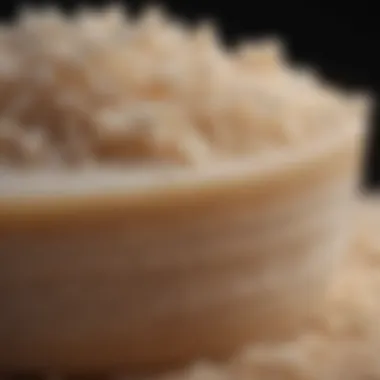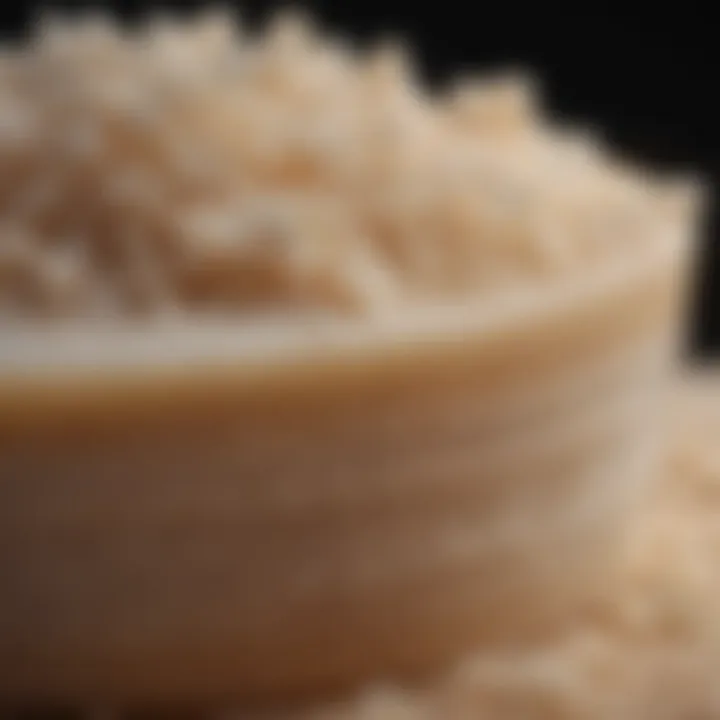Understanding Exfoliation: Enhance Your Facial Health


Intro
Exfoliation is a crucial step in skincare that often gets overlooked. The act of removing dead skin cells can significantly impact the overall health and appearance of the facial skin. Understanding what exfoliation offers helps form a solid foundation for effective skincare. This section aims to shed light on the different facets of exfoliation, leading us into more engaging topics ahead.
Skin is constantly regenerating. Yet, as we age, this process may slow down. Dead skin cells can accumulate, leading to dullness and potential skin issues. Regular exfoliation combats these effects. However, it’s essential to know how often and which methods work best for individual skin types.
In subsequent sections, we will discuss various exfoliation techniques, the benefits tied to this practice, and the suitable methods based on skin type. This awareness elevates one’s skincare regimen significantly, focusing not just on appearances but on longevity and health of the skin itself.
The Importance of Exfoliation
Regular exfoliation serves multiple purposes. It enhances skin texture, allowing for better absorption of topical treatments and moisturizers. Besides, exfoliating reveals fresher skin layers beneath the buildup. Thus, making the skin look more vibrant.
Benefits of exfoliation include:
- Enhanced product absorption. Skin treated with effective exfoliation allows for maximum absorption of skincare products. This method simplifies further steps in skincare, ensuring your moisturizer and treatments work effectively.
- Reduction of breakouts. Exfoliation clears clogged pores, minimizing the chances of forming acne. Regularly removing dead cells promotes a smoother hue as well.
- Improvement in skin visibility. Radiant skin is directly influenced through exfoliation. The removal of the dull outer layers invites a fresh glow and timely cell renewal.
“Exfoliating too aggressively can lead to irritation, so proceed with caution and respect your skin’s needs.”
With the significance of exfoliation understood, it is now important to explore the various methods available. These methods can vastly differ, catering to needs and preferences, providing lets choice for individuals tailored to their unique skin issues.
Exfoliation Methods
Different exfoliation techniques offer unique advantages and potential drawbacks. Knowing these methods helps in making an informed choice. The primary types fall into two categories—physical and chemical exfoliants.
Physical exfoliation involves manually scrubbing dead skin from the surface, employing:
- Scrubs: These granulated rinse-off products can be gentle or abrasive depending on their formulation.
- Tools: Items like brushes or sponges may aid in scrubbing. However, overusing them can irritate sensitive skin.
Chemical exfoliation utilizes acids or enzymes to dissolve dead skin. Common materials include:
- AHAs (Alpha Hydroxy Acids): Such as glycolic and lactic acid. These are ideal for dry skin, offering hydration while exfoliating.
- BHAs (Beta Hydroxy Acids): Salicylic acid is a popular choice. Mostly beneficial for oily and acne-prone skin, it penetrates deeper into the pores.
Each exfoliation type presents its strengths. Factor in skin type, issues, and goals before selecting the right approach to maintain healthy skin.
Post-Exfoliation Care
One cannot overlook the significance of aftercare once exfoliation occurs. Post exfoliation care ensures that the skin remains hydrated and the results last longer.
Key steps for aftercare involve:
- Hydration: Choose a quality moisturizer to seal in hydration after exfoliating.
- Sun Protection: Post-exfoliation skin can be more sensitive. Using sunscreen is critical for preventing sun damage. Aim for a broad-spectrum SPF.
- Avoid heavy products: Heavy or abrasive products should be avoided immediately post-exfoliation. Give the skin time to repair and renew.
By understanding these practices, exfoliation transforms from a daunting task into an exceptional element of one’s skincare routine, promoting healthier and more radiant skin, reaching beyond superficial benefits.
Closure
In peeling back the layers surrounding exfoliation, we uncover its profound impacts on facial health. Every consumer, particularly men attuned to fashion, can unlock a clearer skin journey through informed choice and consistent practice. This emphasizes one’s appearance and self-care habit when engaging with skincare thoughtfully.
Drawing from these insights equips readers with information conducive to refined decisions around their exfoliation practices. Every step informs a comprehensive approach that nurtures not just the outer appearance but enriches confidence as well.
Foreword to Exfoliation
Exfoliation is a crucial aspect of skin care, particularly for the face. Understanding how this process works can enhance its efficacy, leading to healthier skin. In this section, we will explore the concept of exfoliation itself, the reasons for incorporating it into a skin care routine, and its benefits for facial health.
Defining Exfoliation
Exfoliation refers to the removal of dead skin cells from the skin's surface. This is essential because the skin undergoes a continual cycle of regeneration. Without proper exfoliation, dead cells accumulate, leading to a dull appearance and potentially clogging pores. The process can be physical or chemical, each having unique advantages and techniques.
Physical exfoliation involves using tools or products like scrubs, while chemical exfoliation employs acids to dissolve the bonds holding dead cells together. An appropriate exfoliation method aligns with individual skin types and goals, making understanding this practice critical.
The Skin's Natural Renewal Process
The skin's natural renewal process occurs every 28 days typically, with older skin replenishing itself over a month. New skin cells form in the deeper layers, gradually moving up to replace the outer layer. As these skin cells reach the surface, they age and die. Without a method to manage their removal, this natural process can lead to 🧖♀️ issues such as uneven texture, dryness, and excessive oiliness.
When combined with exfoliation, the skin's turnover functions more efficiently. By removing debris and dead cells, exfoliation helps keep skin looking fresh, luminosity is enhanced, and allows the pores to breathe. This makes exfoliation not just a cosmetic choice but an intrinsic part of maintaining optimal skin health.
In summary, exfoliation is not a mere beauty trend but an essential component in achieving and maintaining clear, healthy skin.
The Role of Dead Skin Cells
Exfoliation is an essential aspect of skin care, focusing on the removal of dead skin cells from the surface. These cells are a normal part of the skin's life cycle, but if not removed, they can contribute to various skin problems. Understanding dead skin cells and their role is critical to maintaining skin health. They impact both the appearance and texture of the skin.
Understanding Dead Skin Cell Formation
Every day, the skin sheds dead cells as part of a natural process called desquamation. When new skin cells are formed in the deeper layers of the skin, they rise to the surface, pushing the old cells away. This cycle typically occurs around every 28 days in younger individuals, although it can slow down with age. Various factors, such as environmental conditions, diet, and health, influence this process.
Do remember, when dead skin cells accumulate, they don’t just sit idly; they can cause other issues. Clogged pores are one potential outcome, which can lead to acne formation and worsening of existing skin conditions เช่น pornofilm or eczema. In addition, as the skin loses its ability to effectively shed dead cells, the overall texture and tone may show detriment. The natural radiance that comes from healthy skin can appear dull without consistent exfoliation.


Why Remove Dead Skin Cells?
The removal of dead skin cells offers several advantages. Here are a few key points:
- Boosts Radiance: Removing these cells reveals fresher skin underneath. This creates a more vibrant and healthy glow, which is often desirable in fashion and style circles.
- Avoiding Blemishes: Clogged pores lead to blackheads and acne; removing dead cells minimizes the chances of these problems. Regular exfoliation can significantly enhance skin clarity.
- Improved Texture: A smoother skin surface is the result of effective smoothing out of rough areas caused by accumulated dead skin. This refinement can impact the feel and appearance of the skin thus boost users’ fortitude when applying makeup or other skincare products.
- Enhanced Product Efficacy: When dead skin cells build up, they block products from penetrating deeply. Thus by eliminating them, essences, serums, and moisturizers introduced can perform so much better through improved absorption.
- Encourages Circulation: Exfoliating can boost blood flow to the skin, which supports healthier skin function and recovery. Active circulation is beneficial for cellular rejuvenation.
Overall, including an exfoliation routine can significantly enhance your skincare regimen.
In summary, understanding and respecting the role of dead skin cells in skin health is crucial. Regular attention and removal not only nurture your actual skin condition but are also a cornerstone habit for anyone striving for a polished appearance, especially for those engaged in style and fashion.
Benefits of Exfoliating the Face
The process of exfoliation plays a crucial role in maintaining and improving facial health. Removing dead skin cells demonstrates several advantages beyond mere aesthetics. As men begin to deepen their understanding of grooming and style, recognizing the benefits of exfoliation can be transformative. Effective exfoliation can elevate one's skincare routine. Let's explore the specific advantages.
Improved Skin Texture
Skin texture is an essential aspect of overall appearance. Dead skin cells accumulate on the skin's surface, making it feel rough or appear dull. Regular exfoliation can help slough off these irritating residues.
When exfoliating, many people notice smoother and softer skin right away. This enhanced texture enhances grooming routines and can improve the overall impression an individual makes. Choosing the right exfoliant is key for optimal results.
- Chemical exfoliants like Alpha Hydroxy Acids (AHAs) and Beta Hydroxy Acids (BHAs) are known to effectively promote skin renewal without physical scrubbing.
- Physical options, like scrubs or devices, can yield quick results depending on the technique.
The method selected should suit one’s skin type, promising effective outcomes.
Enhanced Product Absorption
The significance of applying skincare products is not merely in their selection but also in their effectiveness. A common misconception is the notion that a cleanser alone suffices for skincare. However, if the surface layer of the skin is clogged with dead cells, absorbing active ingredients is challenging.
When one exfoliates the face effectively, the product penetrates deeply. This leads to improved outcomes from moisturizers, serums, and treatments. Research suggests that benefits from topically applied vitamins and nutrients can reach their full potential when the skin's surface is adequately prepared through exfoliation.
- Serums applied after exfoliation can significantly deliver results.
- Moisturizers lock in this treatment, ensuring a smooth finish.
Stimulated Circulation
Engaging in exfoliation often contributes to increased blood flow in the facial region. This enhanced circulation provides various intrinsic benefits. It supplies essential nutrients and oxygen to skin cells, thereby promoting healthier and more resilient skin. Over time, good circulation can even help in minimizing the appearance of fine lines and wrinkles.
Furthermore, many exfoliation methods and products can involve massage, which can further boost circulation. Each time the skin is treated, the benefits compound. Choosing to incorporate stimulating practices into one’s regimen is not just a cosmetic intervention but promotes overall skin vitality.
“Regular exfoliation can unlock the full potential of your skincare products, ensuring they're working as effectively as possible.”
In summary, the benefits of exfoliating the face transcend surface-level enhancements. Each of these components combines to contribute to a well-rounded approach to skin health, reinforcing one's high-standards commitment to grooming and style. By acknowledging and implementing proper exfoliation techniques, an individual not only improves texture, product absorption, and circulation but fosters lasting compassion for skin health in the long term.
Types of Exfoliation
Exfoliation is an integral component of skin care that varies significantly in its techniques. Understanding the different types of exfoliation can enhance your skincare routine and optimize skin health. During this section, we will classify exfoliation into two main types: physical and chemical, each providing unique methods of achieving desired results.
Physical Exfoliation Techniques
Physical exfoliation involves the manual removal of dead skin cells through scrubs or devices. This method provides immediate results, enhancing the surface appearance of the skin effectively. Given its tactile approach, many find physical exfoliation satisfying, making it a popular choice in skincare routines.
Scrubs
Scrubs are a leading choice within physical exfoliation. These products typically contain granules, grains, or even natural ingredients like sugar or salt. The key characteristic of scrubs is their abrasiveness, facilitating the mechanical removal of dead skin.
- Benefits of Scrubs:
- Considerations:
- Instant smoothing effect on the skin's surface, revealing a brighter complexion.
- The exfoliating action can stimulate circulation, further promoting skin health.
- While beneficial, scrubs may not be suitable for sensitive skin, potentially leading to irritation.
- Overuse can damage the skin barrier, resulting in redness or peeling.
Overall, scrubs appeal due to their quick ability to enhance skin texture; however, caution is crucial to prevent adverse effects.
Devices
Devices used for physical exfoliation, such as brushes, sponges, or electronic tools, offer another avenue to maintain skin health. These devices vary widely in effectiveness and complexity. Their key feature is the technology that assists in exfoliating skin layers manually or mechanically.
- Benefits of Devices:
- Considerations:
- Many devices provide consistent pressure and coverage, potentially yielding better results than manual scrubbing.
- Electronic devices can often have features like vibration or suction to enhance exfoliation.
- Investment in these devices can be higher than scrubs.
- Usage must be handled with care to avoid irritation or injury to the skin.
Utilizing exfoliating devices can be beneficial, but reader discretion and proper technique are essential to maximize the effects without adverse reactions.
Chemical Exfoliation Techniques
Chemical exfoliation uniquely removes dead skin cells through the application of acids. Unlike physical methods, chemical exfoliation operates at a cellular level, breaking bonds between skin cells for deeper cleansing.
Alpha Hydroxy Acids (AHAs)


AHAs are popular in chemical exfoliants and are effective choices for improving skin texture. These water-soluble acids, such as glycolic or lactic acid, help slough off dead cells, producing a youthful glow.
- Benefits of AHAs:
- Considerations:
- They can effectively treat signs of aging, sun damage, and hyperpigmentation.
- Suitable for dry skin due to their hydrating properties.
- AHAs increase photosensitivity, mandating diligent sun protection.
- For oily or acne-prone skin, they might not be the first-line recommendation, as results can vary.
Hence, AHAs appeal for their multifunctional advantages, especially for those targeting age-related skin issues.
Beta Hydroxy Acids (BHAs)
BHAs, predominantly salicylic acid, target oil and penetrate deep into pores. They stand apart for their oil-solubility, making them especially effective for oily or acne-prone skin.
- Benefits of BHAs:
- Considerations:
- Excellent at unclogging pores and reducing acne breakouts.
- BHAs also have anti-inflammatory properties, helping calm irritated skin.
- Some may experience dryness, necessitating careful application.
- Less effective on dry skin types; individuals should assess skin needs before usage.
Overall, BHAs are particularly useful for those with challenges like acne, ensuring inclusive skincare that tackles issues systematically.
Choosing the Right Exfoliant for Your Skin
Choosing the right exfoliant is crucial for maintaining effective skincare. Exfoliation, if tailored properly, enhances the skin's natural glow and texture. Selecting the appropriate product protects skin integrity and ensures one benefits from the resilience exfoliating offers without suffering from adverse effects. Missteps in this area can lead to irritation, leaving lasting adverse impact on facial health.
Identifying Skin Types
Understanding your skin type is the first key step towards the right exfoliation approach. Most facial skin fall into specific categories. These include normal, oily, dry, sensitive, and combination skin. Each type has its unique requirements, and exfoliation practices must align. For instance, individuals with oily skin may benefit from more aggressive exfoliating methods like chemical peels. This helps clear excess sebum and minimizes acne formation. In contrast, sensitive skin requires gentler approaches, such as mild scrubs or soft chemical exfoliants primarily derived from ingredients that are predominantly naturally based, minimizing potential irritation.
To assess your skin type, consider the following:
- How does your skin feel after cleansing?
- Is it flaky or dry, or prone to excessive oil?
- Are there visible pores or acne breakouts?
- How reactive is your skin to products or environmental conditions?
These questions can point toward insights that guide the selection of exfoliation methods and products tailored to individual needs.
Matching Products to Skin Needs
Once skin type is identified, the next layer involves choosing products that cater specifically to individual skin needs. Different exfoliants serve various purposes and possess unique properties with distinctive benefits. Some aspects to consider in this phase include:
- Sensitivity: For those with sensitive skin, look for formulas that contain soothing elements, such as chamomile or aloe vera. These ingredients calm the skin while still promoting cell turnover.
- Hydration Level: Individuals experiencing dryness might prefer exfoliants that blend acids with hydrating elements such as hyaluronic acid.
- Exfoliant Type: Physical exfoliants, like facial scrubs with natural ingredients, can often remove dead skin efficiently. Chemical exfoliants, such as those containing glycolic or salicylic acid, often penetrate deeper to manage congested pores.
Aligning these elements helps formulate a personalized strategy towards exfoliation, promoting optimal skin health.
In summary, preparing and matching exposure bases decisions can render a proportional advantage. Each skin type has underlying features and reveals insights to personalize exfoliant selections consciously.
Exfoliant choices are more than mere consumer decisions; they represent informed involvement with your skin's maintenance should be a careful consideration woven through the entire skincare routine.
The Exfoliation Process
The process of exfoliation is a crucial step in maintaining skin health. It involves carefully removing dead skin cells, leading to a smoother and brighter complexion. This section lays out the significant considerations and benefits that are essential in the exfoliation routine.
Preparing Your Skin
Before any exfoliation, it is vital to prepare the skin properly. Starting with a clean face is important. Using a gentle cleanser to remove dirt and oil will enhance efficacy. Here are important steps to follow:
- Cleanse: Wash your face with a mild cleanser that suits your skin type.
- Assess: Check your skin for signs of sensitivity, redness, or existing irritation.
- Hydrate: Slightly moist skin may be more receptive to exfoliating products.
It’s also wise to avoid any harsh products or treatments immediately prior to exfoliating, as they can provoke irritation. Ensuring that your face is calm and clean will improve the overall quality of the exfoliation.
The Application Method
Applying the exfoliant appropriately can impact the results significantly. Different products may require unique application techniques. Here’s how to effectively apply exfoliating agents:
- Patch Test: Always conduct a patch test, especially with new products. This may help prevent unwanted reactions.
- Gentle Technique: Use circular motions for physical exfoliants around the face, avoiding excess pressure, particularly on sensitive areas like the cheeks.
- Follow Guidelines: Adhere to the manufacturer’s instructions for chemical exfoliants regarding the amount and duration of application. Setting a timer may help control the exposure time effectively.
After applying, it is important to rinse thoroughly and gently to prevent any product from remaining, which could cause further irritation. Take care not to rub harshly but rather pat dry.
Important: Following the exfoliation routine with adequate hydration is crucial to restore moisture.
Using the right techniques in the exfoliation process greatly enhances any effort taken to improve skin health. By preparing the skin well and employing correct application methods, one can maximize the benefits of exfoliating treatments while minimizing potential side effects.
Frequency of Exfoliation
Exfoliation is a crucial part of a skincare routine. However, many people do not understand how often one should exfoliate. Establishing the right frequency is essential for maintaining healthy skin. It can vary greatly from individual to individual based on several factors. Therefore, finding a suitable routine is more than just selecting the right exfoliant. Here, we discuss key guidelines and considerations to help you tailor your exfoliation frequency.
General Guidelines


When it comes to exfoliation, most dermatologists recommend a few basic guidelines. These recommendations provide a starting point for your routine:
- Typical Frequency: For most skin types, exfoliating two to three times per week is adequate. This range strikes a balance between enabling cell turnover and preventing over-exfoliation.
- Skin Sensitivity: If you have sensitive skin, you may want to consider exfoliating only once a week. Products that are too abrasive or used too often might cause redness or irritation. Always test your skin's reaction.
- Vary by Exfoliant Type: Different exfoliation methods often have varying efficacies. Physical exfoliants like granulated scrubs tend to be harsher. Meanwhile, chemical exfoliants, such as AHAs and BHAs, can usually be applied with greater frequency, depending on strength and formulation.
- Seasonal Changes: Your skin’s needs can change with the seasons. During winter, skin often becomes drier, potentially requiring less exfoliation. Physicians recommend adjusting your routine in accordance with external factors like weather, humidity, or lifestyle choices.
It is critical to listen to your skin during this process. Over time, you will become familiar with your skin’s specific requirements, optimizing the effectiveness of your exfoliation practices.
Considering Individual Factors
It’s not just about following general tips; it’s important to tailor your exfoliation routine based on personal factors. Here are some considerations:
- Skin Type: Identify whether your skin is oily, dry, combination, or sensitive. Oily skin may benefit from more frequent exfoliation, while those with dry skin might damage their skin barrier with excessive exfoliation.
- Unique Skin Conditions: Certain skin conditions like acne, rosacea or eczema may necessitate more caution. Individuals with these issues may need specialized advice from a dermatologist regarding the most suitable exfoliating routine.
- Age: As people age, cell turnover naturally slows down. Older skin might benefit from slightly more frequent exfoliation to counteract signs of aging such as fine lines and dullness. Adjusting exfoliation should be part of an evolving skincare strategy.
- Product Strengths: The potency of the exfoliating product also plays a vital role. Higher concentrations of AHAs or BHAs may allow for fewer applications, while weaker formulations might require more frequent use to achieve visible benefits.
Make nursing awareness regarding how often you should exfoliate skin a priority. Over time, a customized approach will likely result in more vibrant and healthy skin. As always, consult with a skincare professional if uncertain about what is best for your situation.
Frequent exfoliation can have long-term benefits for skin appearance and texture, but it can also pose risks of irritation and damage. Thus, it is entirely wise to engage in responsible exfoliation practices.
Develop a thoughtful routine as you explore the various methods available to handle skin health. Considering both general guidelines and individual factors as essential elements of maintaining a regular exfoliation practice can set the stage for improved efficacy in your skincare strategy.
Potential Risks of Over-Exfoliation
Understanding the potential risks associated with over-exfoliation is crucial for maintaining skin health. While exfoliation is a valuable practice for removing dead skin cells and improving texture, it is also easy to overdo. Excessive exfoliation can lead to various skin issues, making awareness and moderation essential.
Skin Irritation and Sensitivity
One of the immediate consequences of over-exfoliation is increased skin irritation. Overzealous scrubbing or the frequent use of harsh chemical exfoliants can lead to redness, burning sensations, and discomfort. Sensitive skin types are especially prone to this issue. Symptoms may manifest as visible irritation, including flaking or peeling.
To mitigate irritation:
- Assess your products: Check if your exfoliants contain strong irritants like alcohol or high concentrations of acids.
- Limit frequency: Ensure you plan your exfoliation schedule around your skin's tolerance levels.
- Test products slowly: Introduce new exfoliants gradually to observe how your skin reacts.
For many, the key is balance. Skin that becomes too irritated can react negatively to other skincare products, leading to a cycle of discomfort. Thus, knowing when to pause your exfoliation routine is as essential as the practice itself.
Compromised Skin Barrier Function
Another significant consequence of over-exfoliation is the compromise of the skin's barrier function. The skin barrier serves as the first line of defense against environmental factors, bacteria, and allergens. When the barrier is weakened due to excessive exfoliation, the skin may have trouble maintaining proper hydration and may become more susceptible to infections.
Signs of a compromised barrier may include:
- Increased dryness and dehydration.
- Flare-ups of acne or eczema.
- Signs of premature aging due to loss of moisture.
To protect your skin barrier, consider the following:
- Focus on hydration: Incorporating potent hydrators like hyaluronic acid or glycerin can help restore moisture levels in the skin post-exfoliation.
- Soothe with healing ingredients: Look for products that contain ceramides, Panthenol or repair-focused ingredients.
- Understand your skin's signs: React promptly to irritation or discomfort, and consider reducing exfoliation frequency if issues arise.
In summary, moderation is key to achieving desired results without compromising skin integrity.
Ultimately, being cognizant of these potential risks can fortify your exfoliation methods, ensuring that the benefits of exfoliation are maximized while minimizing possible damage.
Post-Exfoliation Care
Post-exfoliation care is essential for maintaining the benefits achieved through the exfoliation process. After the removal of dead skin cells, the skin becomes more receptive to environmental factors, including hydration products and sun exposure. Neglecting aftercare can lead to adverse effects, counteracting the efforts made to rejuvenate the skin.
A well-thought-out post-exfoliation routine can enhance skin health and appearance by replenishing lost moisture and protecting the barrier. Hydration and sun protection emerge as two crucial components of this care regimen. Let's explore these aspects in detail.
Hydration Strategies
Hydration plays a vital role in post-exfoliation care. After exfoliation, the skin often feels dry or tight, indicating a need for moisture replenishment. Using the right products helps restore the skin's natural balance. Here are some effective hydration strategies:
- Choose a Gentle Moisturizer: Select moisturizers that are non-comedogenic and suitable for your skin type. Look for those containing hyaluronic acid, which is known for its ability to hold moisture in the skin.
- Applying Hydrating Serums: Serums with moisture-retaining ingredients can provide an extra layer of hydration. Ingredients like glycerin and aloe vera can soothe and hydrate the skin post-exfoliation.
- Hydration Masks: Consider using a hydration mask once or twice per week. These masks can deliver intense moisture and further assist in recovery.
- Avoid Harsh Products: Steer clear of any harsh cleansers or skincare products that can aggravate irritation after exfoliation. Gentle care will provide optimal results.
Sun Protection
Another crucial aspect of post-exfoliation care is sun protection. Exfoliation can make the skin temporarily more sensitive to UV radiation. If appropriate sun protection measures are not taken, there is a higher risk of sun damage, including premature aging and pigmentation. To effectively protect your skin, adhere to the following guidelines:
- Use a Broad Spectrum Sunscreen: Choose a sunscreen with at least SPF 30 and a broad-spectrum formulation. This protects against both UVA and UVB rays. Apply it every day, regardless of the weather.
- Reapply Regularly: If out in the sun for extended periods, remember to reapply sunscreen every two to three hours. This maintains a consistent level of protection.
- Seek Shade: Try to avoid sun exposure, particularly in peak hours. Staying in the shade when possible further reduces the risk of skin damage.
- Wear Protective Clothing: Hats and long sleeves can also provide an additional barrier against sun harmful effects, especially after exfoliation.
In summary, the role of post-exfoliation care cannot be overstated. Using adequate hydration strategies along with vigilant sun protection ensures that your skin not only recovers effectively but also remains healthy and protected over time.
Closure
Exfoliation is not merely a step in skincare; it is a cornerstone of effective facial health maintenance. This article hasprovided a thorough examination of exfoliation's principles and the vital role of dead skin cell removal. The underlying benefits extend beyond immediate cosmetic improvement. Understanding nutritional exfoliating methods foster healthier skin by promoting regeneration.
Recap of Exfoliation Principles
The process of exfoliation involves the removal of dead skin cells accumulated on the skin's surface. This constant renewal is crucial for maintaining vibrant, receptive skin that positively responds to skincare products. Regular exfoliation contributes to balanced textures, better moisture retention, and improved absorption of beneficial substances from lotions and serums. Recognizing skin types and aligning the correct exfoliating method empowers individuals to take charge of their skin health effectively. Beyond clarity in applicationMethods, factors like technique and ingredients must be aligned with personal skin sensitivity and conditions. Thus, understanding the foundational principles translates to a successful skincare routine.
Encouragement for Incorporating Exfoliation
Incorporating exfoliation into your skincare routine does not have to feel like a chore. It can enhance your skin's health and appearance significantly. Regular exfoliation can reveal brighter skin underneath the layer of dead cells, contributing to a fresh and youthful look.
Consider beginning lightly with gentle physical exfoliants or mild chemical options suited for your skin type. This will help you observe how your skin reacts and adjust accordingly. Consistent exfoliation fosters confidence, enhances your facial aesthetics, and aligns with our modern's man's commitment to refined style and care.
Remember: Cultivating facial health through post-exfoliation care is as essential as the exfoliation process itself. Hydration and UV protection are crucial to maintaining your skin after exfoliating in order to avoid any potential skin issues.
Explore this multifaceted approach to skincare, and allow it to become central to your grooming routine. With conscientious incorporation of exfoliation, your skin can reflect your vitality and sophistication.















